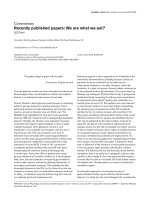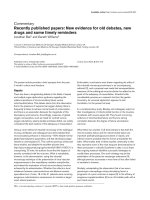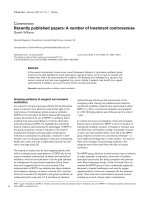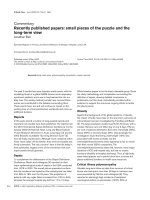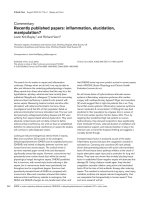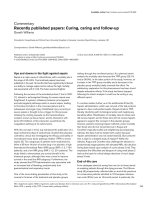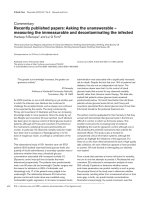Báo cáo y học: " Recently published papers: New evidence for old debates, new drugs and some timely reminders" pps
Bạn đang xem bản rút gọn của tài liệu. Xem và tải ngay bản đầy đủ của tài liệu tại đây (39.94 KB, 4 trang )
FEV
1
= forced expiratory volume in 1 second; NIPPV = face mask positive pressure ventilation.
Available online />The present article provides a brief synopsis from the past
2 month’s critical care literature.
Sepsis
There has been a longstanding debate in the fields of sepsis
and multiple organ dysfunction syndrome regarding the
relative importance of microcirculatory failure versus
mitochondrial failure. This debate stems from the observation
that in the presence of supranormal oxygen delivery there is
frequently a failure to achieve normal levels of consumption,
and there is an association between the magnitude of this
discrepancy and outcome. Accordingly, measures of global
oxygen consumption, such as mixed (or central) venous
oxygen saturations, plasma lactate and base deficit, are widely
considered the best markers of the adequacy of resuscitation.
Using a novel method of intravital microscopy of the sublingual
mucosa, de Backer and colleagues have demonstrated that
microcirculatory perfusion is reduced by ~50% despite normal
global haemodynamic parameters, and that shunting by larger
vessels is commonplace [1]. This confirms previous animal and
tissue studies, and despite the excellent pictures (see
is
unsurprising. Of note, the authors found that the degree of
severity correlated with the outcome. What is remarkable,
however, is the demonstration, using this intravital
microscopy technique of the preservation of local vascular
responsiveness to the vasodilatory mediator acetylcholine,
and indeed the restoration of local microcirculatory function
achieved by its administration. Whether this reflects a local
imbalance between vasoconstrictors and dilators remains
speculative but, of note, 18 of the 21 patients were receiving
exogenous catecholamine vasopressors to maintain a target
mean arterial pressure.
Enthusiastic conclusions were drawn regarding the utility of
this intravital microscopy technique in an accompanying
editorial [2], and a proposal was made that semiquantitative
measures of the sublingual microcirculation be added to the
goals of the adequacy of resuscitation. Intravital holds
considerable promise as a research tool but, like gastric
tonometry, its universal application appears to lack
foundation, for the present at least.
In a complementary study, Brealey and colleagues report on
their investigations of mitochondrial function in the muscles
of patients with severe sepsis [3]. They found convincing
evidence of mitochondrial failure and found a strong
correlation between the degree of failure and adverse
outcome.
What these two studies [1,3] demonstrate is that both the
microcirculatory failure and the mitochondrial failure are
important pathophysiological processes in sepsis, and
indeed it seems probable that the former precipitates the
latter. What makes both of these studies noteworthy is that
they represent some of the most eloquent demonstrations of
these processes in critically ill patients to date. Let us hope
that ongoing research identifies successful strategies to
modify these processes. One such strategy may be the
potentiation of the paracrine messenger adenosine [4],
although previous successes in mice have all too often failed
to translate to humans.
Similarly, extrapolating the observation that a low serum
granulocyte–macrophage colony-stimulating factor is
prognostic of a poor outcome in sepsis [5] to the efficacy of
exogenous supplementation [6] is an oft trodden path with a
poor track record.
Commentary
Recently published papers: New evidence for old debates, new
drugs and some timely reminders
Jonathan Ball
1
and Gareth Williams
2
1
Lecturer in Intensive Care Medicine, St George’s Hospital Medical School, London, UK
2
Clinical Fellow in Intensive Care Medicine, St George’s Hospital, Blackshaw Road, Tooting, London, UK
Correspondence: Jonathan Ball,
Published online: 5 September 2002 Critical Care 2002, 6:407-410
This article is online at />© 2002 BioMed Central Ltd (Print ISSN 1364-8535; Online ISSN 1466-609X)
Critical Care October 2002 Vol 6 No 5 Ball and Williams
Finally, the keenly awaited French ‘steroid replacement’ trial
in sepsis has been published [7]. The first important finding
was a very high incidence of adrenal insufficiency in 229 of
the 299 patients (77%) studied, albeit that interpreting
corticotrophin studies in such patients is controversial.
Interestingly, corticotrophin responsiveness did not predict
outcome. Intensive care unit, hospital, 28-day and 1-year
mortality were very high in all groups (53–77%). In the
responder groups, randomisation to the treatment group
conferred no benefit. In the nonresponders, treatment
conferred a statistically significant survival advantage to
28 days that persisted but ceased to be significant at 1 year
(although the study was not powered to test 12-month
mortality). There were no detectable adverse events
associated with treatment. The regimen of intravenous
hydrocortisone (50 mg, 6 hourly) plus daily enteral
fluorocortisone (50 µg) is arguably too high, and no doubt
future studies will address this. Annane et al. conclude by
advocating universal corticotrophin testing followed by
treatment, which should be withdrawn in responders.
Cardiac failure
There has been growing interest in the natriuretic peptides
for sometime. July saw the publication of a paper by Maisel
et al. demonstrating the diagnostic potential of a bedside
assay for B-type natriuretic peptide in the differential
diagnosis of acute dyspnoea [8]. That study and two studies
from last year [9,10] suggest that levels of these peptides
correlate with the severity of cardiac failure but, as with
troponins as markers of myocardial damage, caution in the
interpretation of results is likely to be required [11].
On the subject of troponin, it is encouraging to find a little
light being shed on the difficulties of its meaningful
interpretation. It has been observed that troponin levels are
elevated in the presence of renal impairment, making
interpretation and therefore diagnosis of acute coronary
syndromes difficult in the critically ill. To investigate this,
Aviles et al. [12] studied whether troponin T levels were
predictive of outcome, a composite of death and myocardial
infarction within 30 days, in a large cohort of patients
(n = 7033) with suspected acute coronary syndrome and
both normal and reduced creatinine clearance. After
adjustment for potential confounding factors, an abnormally
elevated troponin T level (> 0.1 ng/ml) was found to be
predictive of myocardial infarction or death regardless of
renal function.
It is sobering to be reminded that the use of inodilators in the
treatment of acute cardiac failure has never undergone a
large-scale, randomised, controlled trial. However, with the
advent of the novel calcium-sensitising agent levosimendan,
one such trial has now been reported [13]. This trial
randomised 2003 patients with acute or acute on chronic
heart failure to receive 24 hours of either dobutamine or
levosimendan. A higher proportion of those patients who
received levosimendan (29% versus 15%) achieved target
improvements in haemodynamic parameters. More
impressively, a lower proportion of these patients died over
the following 6 months (26% versus 38%). Although
cardiogenic shock and multiorgan failure were exclusion
criteria in this trial, it surely provides evidence to justify similar
studies in critically ill patients with low cardiac output.
On a related point, a thought-provoking if methodologically
suboptimal study of the significant association between the
administration of dopamine and the incidence of delirium [14]
will hopefully result in a more thorough examination of the
neuropsychiatric sequelae of all the commonly used
doperminergic drugs.
On a final cardiac note, the encouraging results of a trial of
ibutilide as second-line therapy in the treatment of atrial
fibrillation in the critically ill [15] suggests that this novel
class III anti-arrhythmic may provide a much needed
treatment for this common condition, which all too often
proves difficult to control.
Respiratory
Attention to simple details is as important, if not more, than
complex and novel interventions. A semirecumbant or upright
posture has been repeatedly demonstrated to result in
superior respiratory and overall outcome. Despite these
demonstrations, however, the implementation of this
intervention appears to be poor. Cook and colleagues have
published a timely survey on this issue [16]. They conclude
that a classic case of system failure exists with regard to
patient positioning, and they suggest a number of useful
strategies to overcome this and similar problems.
At the other extreme of patient positioning, the study by Lee
et al. [17] suggests that instigating the prone position early in
the course of acute lung injury to patients with a larger shunt
and a more compliant chest wall predicts success. Their
study contributes further confirmatory evidence of the clinical
benefit of prone positioning but does nothing to answer the
vital questions regarding how long patients should be in the
prone position for maximum benefit, and indeed whether
improving gas exchange translates into better outcomes.
Against the advancing wave of enthusiasm for face mask
positive pressure ventilation (NIPPV), a significant negative
study has been published [18]. The authors randomised a
heterogeneous group of patients who developed respiratory
distress within 48 hours of extubation to receive standard
therapy or standard therapy plus NIPPV. They found no
benefit from this intervention. To their credit, the authors
acknowledge that more experienced units or targeting
specific patient groups might have achieved a positive
outcome, but they conclude that they cannot recommend
NIPPV as an intervention in this setting. We would argue
from both personal experience and trial evidence that NIPPV
in this setting can prevent the need to reintubate, and that a
trial of NIPPV is sometimes warranted, not least as a failed
trial is unlikely to harm the patient.
Ventilator-associated pneumonia remains a major cause of
morbidity and mortality. The optimal diagnostic technique is
controversial, with some studies suggesting that invasive
methods improve outcome while others have been unable
to demonstrate any benefit from these expensive and time-
consuming investigations. To further this debate, Wu and
colleagues have compared quantitative culture of
endotracheal aspirates, protected specimen brushings and
bronchoalveolar lavage to investigate whether
bacteriological findings correlated in patients with
suspected ventilator-associated pneumonia [19]. They
demonstrated that the less invasive and less work-intensive
technique of quantitative culture of endotracheal aspirates
correlated well with both protected specimen brushings
and bronchoalveolar lavage findings, allowing early
definitive antibiotic choice or cessation of antibiotics in the
case of negative results. Criticism of their investigation
might include the small study number and lack of any
outcome benefit demonstrated, although this was not the
aim of the study. However, a significant impediment to this
approach is the inability to obtain routine quantitative
cultures in many hospitals. With mounting evidence in
favour of quantitative assessment of specimens, this
problem may need addressing.
Magnesium is known to be a bronchodilator and has been
anecdotally reported as having beneficial effects in acute
severe asthma. However, these findings have not been
consistently reproduced in well designed, randomised,
controlled trials. In a welcome attempt to address this issue,
Silverman and colleagues [20] have conducted such a trial
and found that the addition of intravenous magnesium to
standard therapy resulted in a significant improvement in
FEV
1
, at 4 hours, in those with the most severe airway
obstruction (baseline FEV
1
< 25% predicted). Given that
magnesium is safe and inexpensive, and that there is now
good evidence to support its routine use in the severest
cases, it only remains for the optimal dose and duration of
therapy to be established.
Other noteworthy papers
Nasogastric feeding is found to be at least as good as, if not
better than, nasojejunal feeding in the hands of Neumann and
DeLegge [21], essentially because nasojejunal tube
placement results in a significant delay in the start of feeding.
Surely the pragmatic approach is to start with a nasogastric
tube and to only employ the alternatives in cases of failure.
The long-term success of renal allografts from nonheart-
beating donors is reported by Weber and colleagues [22].
Sadly, adoption of this technique, in the UK at least, awaits
the deliberation of the government and judiciary.
Finally, if you have been seduced by the attractive qualities of
alcohol-based hand rubs to reduce crossinfection while
avoiding hand washing, then be warned: your gel may not be
all its cracked up to be [23,24].
In addition to the aforementioned studies, we would also
recommend the following commentaries and reviews
[25–28].
Competing interests
None declared.
References
1. de Backer D, Creteur J, Preiser JC, Dubois MJ, Vincent JL:
Microvascular blood flow is altered in patients with sepsis. Am
J Respir Crit Care Med 2002, 166:98-104.
2. Ince C: The microcirculation unveiled. Am J Respir Crit Care
Med 2002, 166:1-2.
3. Brealey D, Brand M, Hargreaves I, Heales S, Land J, Smolenski R,
Davies NA, Cooper CE, Singer M: Association between mito-
chondrial dysfunction and severity and outcome of septic
shock. Lancet 2002, 360:219-223.
4. Cohen ES, Law WR, Easington CR, Cruz KQ, Nardulli BA, Balk
RA, Parrillo JE, Hollenberg SM: Adenosine deaminase inhibition
attenuates microvascular dysfunction and improves survival
in sepsis. Am J Respir Crit Care Med 2002, 166:16-20.
5. Perry SE, Mostafa SM, Wenstone R, McLaughlin PJ: Low plasma
granulocyte–macrophage colony stimulating factor is an indi-
cator of poor prognosis in sepsis. Intensive Care Med 2002,
28:981-984.
6. Presneill JJ, Harris T, Stewart AG, Cade JF, Wilson JW: A ran-
domized phase II trial of granulocyte–macrophage colony-
stimulating factor therapy in severe sepsis with respiratory
dysfunction. Am J Respir Crit Care Med 2002, 166:138-143.
7. Annane D, Sebille V, Charpentier C, Bollaert PE, Francois B,
Korach JM, Capellier G, Cohen Y, Azoulay E, Troche G, Chaumet-
Riffaut P, Bellissant E: Effect of treatment with low doses of
hydrocortisone and fludrocortisone on mortality in patients
with septic shock. JAMA 2002, 288:862-871.
8. Maisel AS, Krishnaswamy P, Nowak RM, McCord J, Hollander JE,
Duc P, Omland T, Storrow AB, Abraham WT, Wu AH, Clopton P,
Steg PG, Westheim A, Knudsen CW, Perez A, Kazanegra R, Her-
rmann HC, McCullough PA: Rapid measurement of B-type
natriuretic peptide in the emergency diagnosis of heart
failure. N Engl J Med 2002, 347:161-167.
9. Hartemink KJ, Groeneveld AB, de Groot MC, Strack van Schijndel
RJ, van Kamp G, Thijs LG: Alpha-atrial natriuretic peptide,
cyclic guanosine monophosphate, and endothelin in plasma
as markers of myocardial depression in human septic shock.
Crit Care Med 2001, 29:80-87.
10. Mazul-Sunko B, Zarkovic N, Vrkic N, Klinger R, Peric M, Bekavac-
Beslin M, Novkoski M, Krizmanic A, Gvozdenovic A, Topic E: Pro-
atrial natriuretic peptide hormone from right atria is
correlated with cardiac depression in septic patients. J
Endocrinol Invest 2001, 24:RC22-RC24.
11. Wu AH: Increased troponin in patients with sepsis and septic
shock: myocardial necrosis or reversible myocardial depres-
sion? Intensive Care Med 2001, 27:959-961.
12. Aviles RJ, Askari AT, Lindahl B, Wallentin L, Jia G, Ohman EM,
Mahaffey KW, Newby LK, Califf RM, Simoons ML, Topol EJ,
Berger P, Lauer MS: Troponin T levels in patients with acute
coronary syndromes, with or without renal dysfunction. N Engl
J Med 2002, 346:2047-2052.
13. Follath F, Cleland JG, Just H, Papp JG, Scholz H, Peuhkurinen K,
Harjola VP, Mitrovic V, Abdalla M, Sandell EP, Lehtonen L: Effi-
cacy and safety of intravenous levosimendan compared with
dobutamine in severe low-output heart failure (the LIDO
study): a randomised double-blind trial. Lancet 2002, 360:196-
202.
14. Sommer BR, Wise LC, Kraemer HC: Is dopamine administra-
tion possibly a risk factor for delirium? Crit Care Med 2002,
30:1508-1511.
Available online />15. Hennersdorf MG, Perings SM, Zuhlke C, Heidland UE, Perings C,
Heintzen MP, Strauer BE: Conversion of recent-onset atrial fib-
rillation or flutter with ibutilide after amiodarone has failed.
Intensive Care Med 2002, 28:925-929.
16. Cook DJ, Meade MO, Hand LE, McMullin JP: Toward under-
standing evidence uptake: semirecumbency for pneumonia
prevention. Crit Care Med 2002, 30:1472-1477.
17. Lee DL, Chiang HT, Lin SL, Ger LP, Kun MH, Huang YC: Prone-
position ventilation induces sustained improvement in oxy-
genation in patients with acute respiratory distress syndrome
who have a large shunt. Crit Care Med 2002, 30:1446-1452.
18. Keenan SP, Powers C, McCormack DG, Block G: Noninvasive
positive-pressure ventilation for postextubation respiratory
distress: a randomized controlled trial. JAMA 2002, 287:3238-
3244.
19. Wu CL, Yang D, Wang NY, Kuo HT, Chen PZ: Quantitative
culture of endotracheal aspirates in the diagnosis of ventila-
tor-associated pneumonia in patients with treatment failure.
Chest 2002, 122:662-668.
20. Silverman RA, Osborn H, Runge J, Gallagher EJ, Chiang W,
Feldman J, Gaeta T, Freeman K, Levin B, Mancherje N, Scharf S:
IV magnesium sulfate in the treatment of acute severe
asthma: a multicenter randomized controlled trial. Chest
2002, 122:489-497.
21. Neumann DA, DeLegge MH: Gastric versus small-bowel tube
feeding in the intensive care unit: a prospective comparison
of efficacy. Crit Care Med 2002, 30:1436-1438.
22. Weber M, Dindo D, Demartines N, Ambuhl PM, Clavien PA:
Kidney transplantation from donors without a heartbeat. N
Engl J Med 2002, 347:248-255.
23. Kramer A, Rudolph P, Kampf G, Pittet D: Limited efficacy of
alcohol-based hand gels. Lancet 2002, 359:1489-1490.
24. Kramer A, Bernig T, Kampf G: Clinical double-blind trial on the
dermal tolerance and user acceptability of six alcohol-based
hand disinfectants for hygienic hand disinfection. J Hosp
Infect 2002, 51:114-120.
25. Laffey JG, Kavanagh BP: Hypocapnia. N Engl J Med 2002, 347:
43-53.
26. Hubmayr RD: Perspective on lung injury and recruitment: a
skeptical look at the opening and collapse story. Am J Respir
Crit Care Med 2002, 165:1647-1653.
27. Maloney JP: Lessening the punch of heparin-induced thrombo-
cytopenia. Chest 2002, 122:5-6.
28. Chu J, Wang RY, Hill NS: Update in clinical toxicology. Am J
Respir Crit Care Med 2002, 166:9-15.
Critical Care October 2002 Vol 6 No 5 Ball and Williams

